
The University of Illinois Experimental Dairy Farm Historic District, also known as South Farm, is a designated historic district in the U.S. state of Illinois. It is located on the campus of the University of Illinois in Urbana, Illinois. The district consists of eight contributing structures and several non-contributing structures. The district was designated in 1994 when it was added to the National Register of Historic Places as part of the Multiple Property Submission concerning Round Barns in Illinois. Three of the district's buildings are early 20th century round barns constructed between 1908 and 1912. The district covers a total area of 6 acres (2 ha).

Ron George Round Barn is a round barn northeast of the U.S. village of Romeoville, Illinois. It was originally constructed for Frank Eaton c. 1912–13 in Bolingbrook, Illinois.

The three University of Illinois round barns played a special role in the promotion and popularity of the American round barn. They are located in Urbana Township, on the border of the U.S. city of Urbana, Illinois and on the campus of the University of Illinois Urbana-Champaign. The University of Illinois was home to one of the Agricultural Experiment Stations, located at U.S. universities, which were at the heart of the promotion of the round barn. At least one round barn in Illinois was built specifically after its owner viewed the barns at the university. Though originally an experiment the three barns helped to lead the way for round barn construction throughout the Midwest, particularly in Illinois. The barns were listed as contributing properties to the U of I Experimental Dairy Farm Historic District, which was listed on the U.S. National Register of Historic Places in 1994.

The John Scott Farm is a historic farmstead near the community of Shandon, Ohio, United States. Established in the nineteenth century and still in operation in the twenty-first, the farmstead has been named a historic site because of its traditionally built agricultural structures.

The James Bruce Round Barn is a round barn located near the Stephenson County, Illinois city of Freeport, United States. The barn was constructed in 1914 by the team of Jeremiah Shaffer and the Haas Brothers, who were responsible for at least a dozen round barns in the area. The barn features a single hip roof design which was probably influenced by the Agricultural Experiment Stations at the University of Illinois and the University of Wisconsin–Madison. The Bruce Round Barn was the last known round barn designed by the Shaffer–Haas team. The building was listed on the U.S. National Register of Historic Places as part of a multiple property submission in 1984.

The Charles Fehr Round Barn is a round barn in the U.S. state of Illinois near the Stephenson County village of Orangeville. The barn was built in 1912 by the team of Jeremiah Shaffer and the Haas Brothers about one half mile from the Illinois–Wisconsin state border. The building is the first round barn in the Stephenson County area, home to 31 round barns, with a hip roof. The building was added to the U.S. National Register of Historic Places in 1984.

Castle Farms is a special events facility located in Charlevoix, Michigan. It was constructed in 1918 by Albert Loeb, who was the Vice President of Sears, Roebuck and Company, and it was designed by Arthur Heun.

The Buckner Homestead Historic District, near Stehekin, Washington in Lake Chelan National Recreation Area incorporates a group of structures relating to the theme of early settlement in the Lake Chelan area. Representing a time period of over six decades, from 1889 to the 1950s, the district comprises 15 buildings, landscape structures and ruins, and over 50 acres (200,000 m2) of land planted in orchard and criss-crossed by hand-dug irrigation ditches. The oldest building on the farm is a cabin built in 1889. The Buckner family bought the farm in 1910 and remained there until 1970, when the property was sold to the National Park Service. The Buckner Cabin was listed on the National Register of Historic Places in 1974. The rest of the Buckner farm became a historic district in 1989. Today, the National Park Service maintains the Buckner homestead and farm as an interpretive center to give visitors a glimpse at pioneer farm life in the Stehekin Valley.
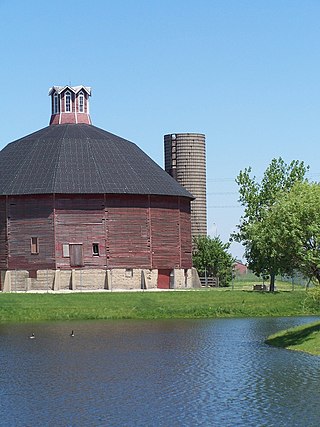
Teeple Barn was a historic structure in Elgin, Illinois. It was a sixteen-sided barn designed by W. Wright Abell for Lester Teeple, a dairy farmer. In 1979, it was added to the National Register of Historic Places as the only surviving sixteen-sided barn in Illinois. The barn was destroyed on May 27, 2007, following a storm. It was delisted from the National Register in 2020.

The Nebergall "Knoll Crest" Round Barn is located between Davenport and Blue Grass in rural Scott County, Iowa, United States. It was built in 1914, and has been listed on the National Register of Historic Places since 1986.
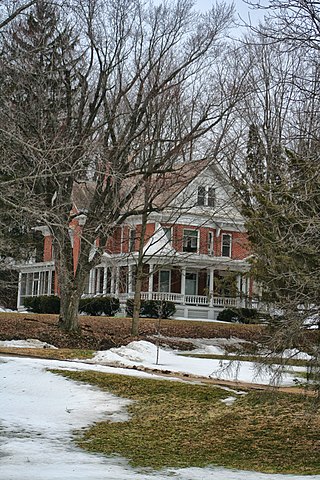
The Freitag Homestead is a historic farm begun in 1848 in the town of Washington, Green County, Wisconsin. It is also the site of the first Swiss cheese factory in Wisconsin. The farm was added to the National Register of Historic Places in 2005.

The Gempeler Round Barn near Orfordville, Wisconsin, United States, is a round barn built about 1912, unusual in that its central support is the trunk of an oak tree, three feet across at the top. The barn was listed on the National Register of Historic Places (NRHP) in 1979.

The Corson Emminger Round Barn near Watertown, South Dakota, United States, is a round barn that was built during 1909–1910 by Corson Emminger. It was listed on the National Register of Historic Places in 1978.
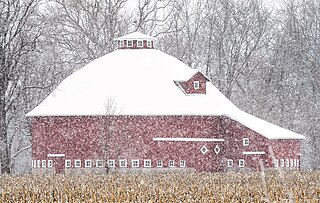
The John Haimbaugh Round Barn in Newcastle Township near Rochester, Indiana, United States, is a round barn that was built in 1914. It was listed on the National Register of Historic Places in 1993.

The Foster Farm Barn is a historic dairy barn at 538 Augusta Road in Belgrade, Maine. Built sometime between 1900 and 1910, it is a well-preserved example of a barn built during a transitional period between mixed-use farming and specialized dairy farming. It was listed on the National Register of Historic Places in 2015.
The Pettigrew Barns, also known as Severtson Barns, near Flandreau, South Dakota, are barns which were built in about 1901. They were listed on the National Register of Historic Places in 2004. As of 2004 the barns were owned by Craig Severtson.
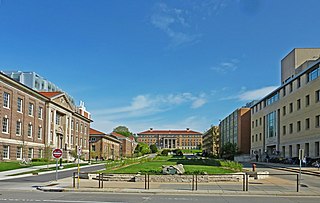
The Henry Mall Historic District is a landscaped mall and the surrounding academic agriculture buildings on the University of Wisconsin–Madison campus, roughly laid out by architects Warren Laird and Paul Cret from 1906 to 1908, with buildings constructed from 1903 to 1961. In 1992 the district was added to the National Register of Historic Places.

The John Sweet Donald Farmstead is a historic farm in Springdale, Wisconsin with surviving structures built as early as 1858. It is significant as the home and testing grounds of John Sweet Donald, a farmer, statesman, and educator of the Progressive Era.
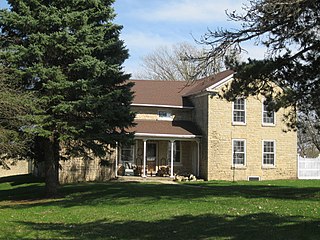
The Samuel Hall House is a Greek Revival-styled farmhouse built in 1856 in Albion, Dane County, Wisconsin. It was added to the State and the National Register of Historic Places in 1993.



















